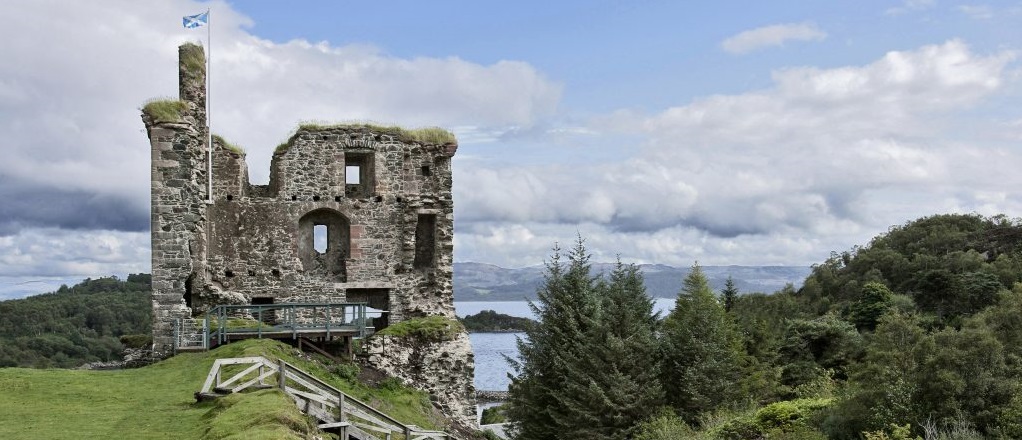Kintyre: castles and history speak volumes
Kintyre extends 40 miles from Mull of Kintyre in the south, to Tarbert in the north. The peninsula is no more than ten miles wide, at Tarbert it’s just a mile. The name in the Gaelic Tairbeart, literally translated as “draw-boat” and as “isthmus”, Tarbert was important for the herring as far back as 836 when it was mentioned in the famous old Annals of Ulster. People have lived at the head of Campbeltown Loch for thousands of years, from the Bronze and Iron ages, then early Christians, through the Kingdom of Dalriada, the Norse invaders, the MacDonald Lords of the Isles, and the brutal Covenanters of the 17th Century. All have left their mark carved in the landscape.
Scotii influence; the Irish version of the Christian faith followed the route into Scotland. On his way to found the church on Iona which would become the spiritual centre of Scottish Christianity for centuries, St Columba arrived first in 563 AD. He went on to be crowned King Aidan of Dalriata, the first time that any king on the British Island was given a christian blessing. Within two centuries of Aidan’s death in 605 AD Dalriata had trouble with Vikings. Only after the Scots gained the military advantage in the 13th century did they wrest the Isles and Kintyre back from the Vikings. Dal Riata were the people who came from Ireland (the Scotti). After battles with the Picts, they were forced to return to Ulster but they returned in AD503 and became the founders of the kingdom of the Scots. Their greatest King was Aedan, the first king of Dal Riata to be consecrated on Iona by St. Columba. Through intermarriage with the Picts he established the ultimate nucleus of Scotland. He was succeeded by Kenneth MacAlpin who was recognised as king of all Scotland, ruling from AD843 to AD858. He was Pictish on his mother’s side and carried the royal line of Gabran from his father. From the late eighth century the western coast was raided by the Vikings. The most significant legacy that the Vikings brought was their longboats, giving to the Scots their first lessons in seamanship.
Somerled Uprising A new Gaelic aristocracy emerged in the tenth and eleventh centuries. Somerled, Ri Airir Gaidheal, Ruler of the coastland of the Gael, was a descendant of Godfraidh mac Fergus, Lord of the Hebrides, who died in A.D 853. The family of Somerled had always been associated with the Scottish Dal Riata. Saddell Abbey is reputed to be the burial place of Somerled. He founded the Abbey but was killed in 1164 before the Abbey was completed. The Abbey was finished by his son soon after 1200. Somerled took control of Kintyre (and much of the West Coast) from the Vikings and held it for several generations, founding Clan MacDonald, Macruari and Alisdair (Macalistair) in the process until 1493 AD when due to increasing conflict with the Scottish crown, the power of the Lordship was finally broken.
Castle MacEwen On the shore of the loch near Kilfinan stands the remains of a fortress once owned by Clan Ewen of Otter. The first structure was a medieval dun, or fortified tower. In the year 1432 the chief Swene MacEwen of Otter surrendered his barony to King James I who granted it to Celestine Campbell in the event that Swene should die without an heir. Swene died in 1493, the lands passed to Clan Campbell along with the castle. Eventually, the fort was turned into a medieval homestead. In 1969, a round house was discovered. Other finds included a 12th-century crucifix, a 15th-century groat, and 13th and 18th century pottery shards. All finds sent to the Glasgow Art Gallery and Museum.[
Old Castle Lachlan This ruined 15th-century castle stands in a beautifully picturesque location near the head of the loch, on the eastern shore. It was built for Clan MacLachlan but was heavily damaged in 1746 when it was attacked by government soldiers. The clan built a new house to the north-east of the medieval castle, leaving it to fall into decay, now a romantic ruin.
Skipness Castle Norway ruled Argyll in the 1200s, but the Norse’s days here were drawing to a close – in 1263, Hakon IV was defeated by the Scots at the Battle of Largs. By the end of the century, the MacDonalds had control of Skipness. Scotland and England were locked into the Wars of Independence, the MacDonalds rebuilt Skipness as a formidable stronghold in 1300. Their works included: the construction of the new chapel by the shore, which is surprisingly well-preserved, the incorporation of the chapel and hall house into an impressive residence, construction of a stone curtain wall to enclose the new buildings, bristling with arrow slits and topped with a notched parapet wall. The MacDonalds held Skipness until 1493, and in 1502 it was granted to the Campbell earls of Argyll who completed the conversion of the buildings to a tower house.
Tarbert Castle High on a hill overlooking Tarbert harbour stand the ruins of this striking medieval fortress, associated with King Robert Bruce. We do not know when the first castle was erected, but we do know that in 1325 Bruce repaired and extended an existing castle. In 1494 James IV rebuilt Bruce’s castle and later bestowed it on the chief of Clan Campbell. In the early 16th century, it was the base for a pirate named Alan-nan-Sop, who raided throughout Argyll and across to Ireland. It later passed to the McAlister family, but by the 18th century, it was allowed to fall into ruin.
Dunaverty Castle Southend at the southern end of the Kintyre peninsula in western Scotland. The site was once a fort belonging to the Clan Donald (MacDonald). Little remains of the castle, although the site is protected as a scheduled monument. The remains of Dunaverty Castle stand on a rocky head land built on forms a natural stronghold with the sea on three sides and is only approachable from the north. It is attached to the mainland only by a narrow path. It is known that the castle itself was accessed by a drawbridge In 1263, Dunaverty Castle was garrisoned by Alexander III, King of Scotland during the Norwegian campaign of Hákon Hákonarson, King of Norway. During the Civil War Dunaverty was besieged in 1647 by Scottish supporters of Oliver Cromwell who were led by General David Leslie (Leslie later became a Royalist). The MacDonalds surrendered and then 300 of them were massacred. This incident became known as the Battle of Dunaverty, or “Dunaverty Massacre”.
Saddell Abbey was a Cistercian monastery founded in 1207 by Ragnall, son of Somairle mac Gille Brigte and peopled by monks from Mellifont Abbey in Ireland. Somerled’s descendants, the MacDonalds, Lords of the Isles, continued to be patrons of Saddell abbey. Not a great deal remains of Saddell Abbey itself. And almost nothing remains of the square of buildings surrounding a cloister that once stood to the south of the abbey church. The rest of the abbey has been recycled into buildings such as Saddell Castle and Saddell House. A collection of medieval grave slabs and effigies that marked burials here are now protected from the elements in a purpose-built shelter at the car park end of the site.There are twelve of these stones on show at Saddell, dating back to the 1300s or 1400s. Ten are displayed in back to back displays along the centre of the shelter. The most immediately striking are the five carrying carved figures depicting the people whose graves they originally marked: effigies. Two of these seem to have been priests, though one is now headless. The other three are West Highland lords in full armour. Somerled’s son Raghnall, or Reginald, re-endowed the abbey in 1160 and it seems to have continued in being for a further three and a half largely unrecorded centuries.

